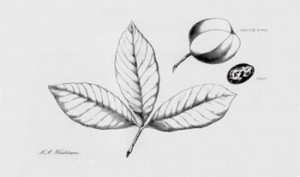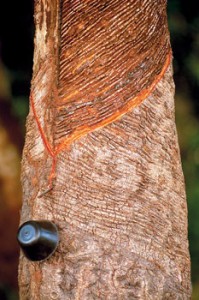 Artistic combination of reproductions from the books The thief at the end of the world and Fordlandia, by Greg GrandinThe pun is inevitable and, perhaps, pardonable: time has always been elastic in the history of Henry Wickham. He filched the rubber tree seeds back in 1876, but it was only in 1895 that the English decided to start a commercial rubber plantation in Malaysia and, thus, it was only toward the end of his life that Wickham earned the British Empire’s official thanks, becoming Sir, to the despair of Queen Victoria, who regarded him as “a disagreeable little man”. For decades there were discussions, with no satisfactory conclusion being reached, as to whether he behaved like a common thief or whether he was a “man of his time”; either way, he earned the moniker “the father of bio-piracy”. Much later, after Eco-92, a discussion arose regarding the subtleties of this issue. “In the preceding decade, in international law, the concepts derived from farmer’s rights at the United Nations’ Food and Agriculture Organization (FAO) were prevalent. They were based on the principle of the common good of mankind and proposed that natural resources be accessible to all. The discussion now is whether – Brazil imposing a very inflexible access law – people will go and do their research elsewhere or whether they will try to collect their samples without official authorization, which characterizes bio-piracy. The main interest involving Brazil is actually a major challenge: how to transform all potential bio-piracy into bio-partnerships in order to strengthen the country’s technological capacity”, evaluates Ana Flávia Granja e Barros, an associate professor at the University of Brasília/International Relations Institute. Time does not appear to have redressed Wickham’s reputation. Was he really the party responsible for the decline of Brazil’s rubber cycle?
Artistic combination of reproductions from the books The thief at the end of the world and Fordlandia, by Greg GrandinThe pun is inevitable and, perhaps, pardonable: time has always been elastic in the history of Henry Wickham. He filched the rubber tree seeds back in 1876, but it was only in 1895 that the English decided to start a commercial rubber plantation in Malaysia and, thus, it was only toward the end of his life that Wickham earned the British Empire’s official thanks, becoming Sir, to the despair of Queen Victoria, who regarded him as “a disagreeable little man”. For decades there were discussions, with no satisfactory conclusion being reached, as to whether he behaved like a common thief or whether he was a “man of his time”; either way, he earned the moniker “the father of bio-piracy”. Much later, after Eco-92, a discussion arose regarding the subtleties of this issue. “In the preceding decade, in international law, the concepts derived from farmer’s rights at the United Nations’ Food and Agriculture Organization (FAO) were prevalent. They were based on the principle of the common good of mankind and proposed that natural resources be accessible to all. The discussion now is whether – Brazil imposing a very inflexible access law – people will go and do their research elsewhere or whether they will try to collect their samples without official authorization, which characterizes bio-piracy. The main interest involving Brazil is actually a major challenge: how to transform all potential bio-piracy into bio-partnerships in order to strengthen the country’s technological capacity”, evaluates Ana Flávia Granja e Barros, an associate professor at the University of Brasília/International Relations Institute. Time does not appear to have redressed Wickham’s reputation. Was he really the party responsible for the decline of Brazil’s rubber cycle?
“Long before this smuggling episode, there was some enthusiasm for ‘natural theology’, particularly in the British Empire. The argument was that, although the unity of the Garden of Eden had been lost, free trade could enable the rediscovery of its agricultural riches. Then, in 1851, Macintosh & Co., the largest British rubber manufacturer, presented Prince Albert, Queen Victoria’s husband, with a rubber bar on which William Cowper’s poem Charity was inscribed, as follows: ‘the band of commerce was design’d To associate all the branches of mankind. Each climate needs what other climes produce, And offers something to the general use’. Therefore, stealing seeds could be a ‘noble action’ for the ‘common good’ of mankind”, explains historian Emma Reisz, from Jesus College, Oxford, author of The political economy of empire in the tropics: rubber in the British Empire, to be released at the end of this year in England. “For this reason, Wickham never regarded the smuggling of the seeds as theft, but as an act of patriotism and personal salvation. Long before OPEC, his act of bio-piracy gave England the first global monopoly of a strategic resource in the history of humankind”, adds Joe Jackson, author of the newly released biography of Wickham, The thief at the end of the world. If on the one hand the nobility looked down upon him, on the other hand, the fruit of his adventure glorified the Royal Botanical Gardens at Kew (which are celebrating their 250th anniversary this year), a notable botanical research institution, that housed and encouraged not only the stolen Brazilian seeds, but of many others, such as cinchona or quinine, filched by English researchers from Peru, in keeping with the spirit of “the common good of mankind”. In reality, the desire for quinine had less to do with universalist altruism and more to do with the Empire’s need to fight the malaria that struck the British soldiers in distant lands, getting in the way of colonial trade.

reproductionHenry Wickham: thief or hero?reproduction
“The partnership agreement between the colonial government and botanical gardens for the transfer and development of useful plants was a mutually beneficial arrangement. State subsidies for these centers rose when governments awoke to the strategic potential of botany. The institution, in turn, in retribution for the national investment, researched and improved seeds for plantations”, explains historian Lucile Brockway, from the City University of New York, author of Science and colonial expansion. “Tropical monoculture in European hands advanced greatly, but also produced huge political and environmental imbalances that the modern world still has to deal with”. The nineteenth century, she adds, emphasized “economic botany”, i.e., “colonial botany”, and institutions such as Kew Gardens, which the government at first regarded as a “royal whim” or “entertainment for the masses”, gained status in the imperial hierarchy as the British Empire’s “clearing houses” for the exchange of botanical information, and as centers for plant exchange, from which samples and seeds were dispatched to wherever they might show commercial potential.
Thus, in 1850, when Thomas Hancock, Macintosh’s owner, publicly expressed his concern about the Brazilian rubber monopoly, which, according to him, was not reliable in terms of supply and pricing, Sir William Hooker, his friend and the director or Kew Gardens, volunteered to “offer all and any help to whosoever might want to transfer the rubber tree from Brazil to imperial territory”. “The market’s ‘invisible hand’, it seems, needed a bit of a push. However, getting the Brazilian seedlings demanded botanical knowledge and the courage to take on the jungle, while market prices were still relatively low and did not justify the effort’, comments Emma. The British government was not interested and it was only as from 1870, as a result of the pressure of English authorities in India, who needed rubber, that the India Office, in London, began to ponder this issue seriously, along the lines of what had been done with regard to quinine. Finally, an official report on Brazil’s situation warned that there was a danger of losing – one of “mankind’s assets” at the hands of a “drunken rubber collector that, after a night of drinking, might destroy all the trees in his way”. “It was a matter of civility to yank rubber out of Brazil and, in 1873, the India Office earmarked some funds to obtain rubber tree cuttings or seeds”, says Emma.

reproductionWickham’s famous drawing of an Hevea brasiliensis leafreproduction
Several attempts were made, but the seeds would not grow at Kew, which rather depressed Hooker, even when he received a letter from Wickham in which the latter promised to be able not only to recognize the right sort of tree, but also to send thousands of seeds, safely, to Kew Gardens. A typical adventurer of the times, Henry, at 27, left for Central America to try to get rich and landed up in Santarém, where he witnessed, in loco, the wealth that the rubber boom had created. Previously, on the Orinoco river, he had learnt from the natives how to collect the rubber sap. His travel narratives, with drawings of the Heavea leaves, persuaded the India Office that he had potential, after his project had been put on the backburner for six months. In 1876, Wickham returned to Brazil with his wife, his mother, his brother and his sister-in-law (he lost most of his family here to tropical diseases), and wrote to Hooker from Seringal, on the banks of the Tapajós river (fairly close to where the future Ford company would establish itself) warning him that he had collected the seeds. On board the ship Amazonas, along with 70 thousand seeds, he declared to the Brazilian customs that he “was only carrying exotic and delicate specimens for the botanical garden”. To this end, he had the help of the British consul and of the “Baron of S.”, who was “very understanding”. “They did not act against the wishes of the Brazilian government, but as if the latter did not exist, as if the only authorities in that corner of the world were the British consuls”, comments Warren Dean. The seeds arrived in London safe and sound and were sent on to British Asia.
“However, the development of large-scale plantations in that region was slow, due to a shortage of capital and lack of interest among the English tradesmen, who only reacted once rubber’s potential rocketed as result of the car industry”, analyzes economist Aldo Musacchio, from Ibmec São Paulo. In 1900, the Asian plantations yielded only four tons of latex, vs. the 27 thousand tons obtained from extraction in the Brazilian jungle. However, by 1916, the British plantations were producing enough Hevea to meet 95% of the world’s demand for high quality rubber. The Amazon Region plummeted. “Why didn’t the Brazilian producers react? Contrary to what people think, the rubber oligarchy made no ‘fatal error’; to the contrary, it took ‘optimized action’, in the light of the available options”, analyzes economist Zephyr Frank, from Stanford University. “Incapable of avoiding the smuggling of seeds, the only option for the Brazilians would have been a major investment in production, to scare off the incipient competition, by means of a productivity increase, the importation of manpower, a reduction in the cost of labor and the organization of plantations. But the country, at that time, lacked the capacity to mobilize such capital resources (and also had no interest in doing so, because of coffee) and the work to turn the game around”, he explains. “As the rubber market is unpredictable and slow (it depends on the time the trees take to grow – six to eight years), Brazilians chose to ‘sit and wait’, because investing in plantations was too expensive and devoid of assurances; moreover, extraction from the forest was lucrative, in its own fashion. The alternative was to allow the English to invade the market until production became excessive, as happened in 1922.”

FERNANDA PRETO/FOLHA IMAGEMCollecting latex today: few changesFERNANDA PRETO/FOLHA IMAGEM
Now, time was on the side of Brazilian rubber. The British control of this industry depended on privileged colonial relations, which provided plentiful, cheap labor. The Empire’s decline and pressure from the US, which required more rubber at lower cost, the initial advantage vanished. “The rubber issue was, at one and the same time, emblematic of colonial power and indicative of its decadence. When they tried to prop up the cartel they no longer had the power to keep the Americans from seeking rubber elsewhere, as Ford did in Brazil”, says Emma. There was also the environmental factor. “The British extolled the civility of the plantations versus the alleged lack of civility of the jungle extraction system, a perception shared by the coffee-growing elites then in power. The official policy, particularly after the advent of the Republic, bought into this notion and promoted these plantations, disregarding local know-how and the views of the local rubber producers, who did not agree with the promotion of monoculture. For them, extractivism guaranteed perennial production and did not destroy the soil or the trees, contrary to the ‘civilized’ alternative”, analyzes historian Rosineide Bentes, from the University of the State of Pará. “Promoting this monoculture clashed with the environmental notions of the rubber producers, for whom preserving the forest had a deep economic and ecological meaning. They realized, long before the scientists, that the plantations were an easy target for pests. Thus, a monoculture did not proliferate in the Amazon Region, among other reasons, because the producers believed that it would destroy their main capital: the native elastic gum forest. Thus, they made history, by choosing their own alternative and refusing to surrender to the jungle or to the industrializing forces”, believes the researcher.
Republish